It can be very useful to understand how to photograph the moon with your digital camera. Sometimes, you might want to capture the Moon when it is full and beautiful, while other times you might want to capture an interesting event like a Lunar Eclipse.
Either way, the process of photographing the Moon starts with your choice of camera gear – although shooting technique and post-processing are just as important. In this article, we explain everything you need to know about Moon photography from start to finish.

Moon Photography Challenges
If you have previously attempted to capture the Moon and it came out very small or looked like a white blob, don’t be frustrated. Many photographers go through similar pains the first time they try it out. Moon photography can be difficult and frustrating, which is why we wrote this guide for you.
Despite all the challenges, photographing the Moon is a great learning experience, especially if you are willing to experiment a little. You will learn all sorts of techniques along the way: reducing camera shake in low-light conditions, dealing with wind and heat wave distortion for distant subjects, manually setting your camera, and even incorporating the moon into other photos (with more than just the moon as your subject)!
Moon photography is exciting, because you can do it in so many different ways. You can take a picture of the Moon by itself with a telephoto lens and capture its details, including its big craters. You can photograph an interesting landscape or a scene with the Moon as part of the composition. You can even create a composite image, combining a previously captured image of the Moon with a cool-looking subject, as can be seen in the example below:
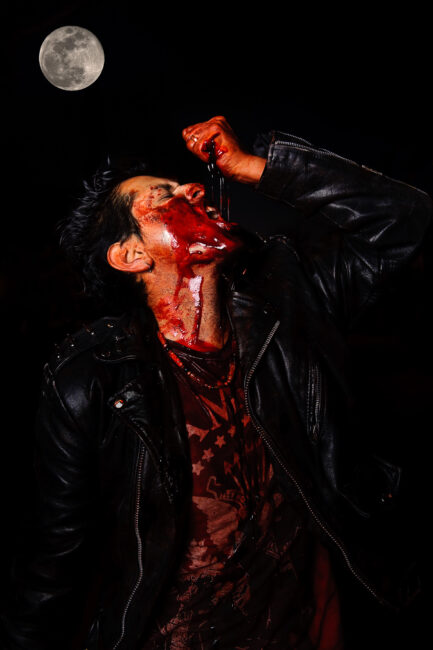
Moon Phases Explained
Before we talk about how you can photograph the Moon, it is important to understand the basics of Moon phases.
As you already know, the Moon goes through different phases throughout the month. When the Moon is between the Earth and Sun, we get a “New Moon” because no sunlight falls on the side of the moon facing us. When the opposite is true – the Earth is between the Moon and Sun – the side of the moon facing us is lit up, and we get a Full Moon.
This cycle repeats itself every 29.53 days, which is called its “synodic period.” Here is a diagram of different Moon phases:
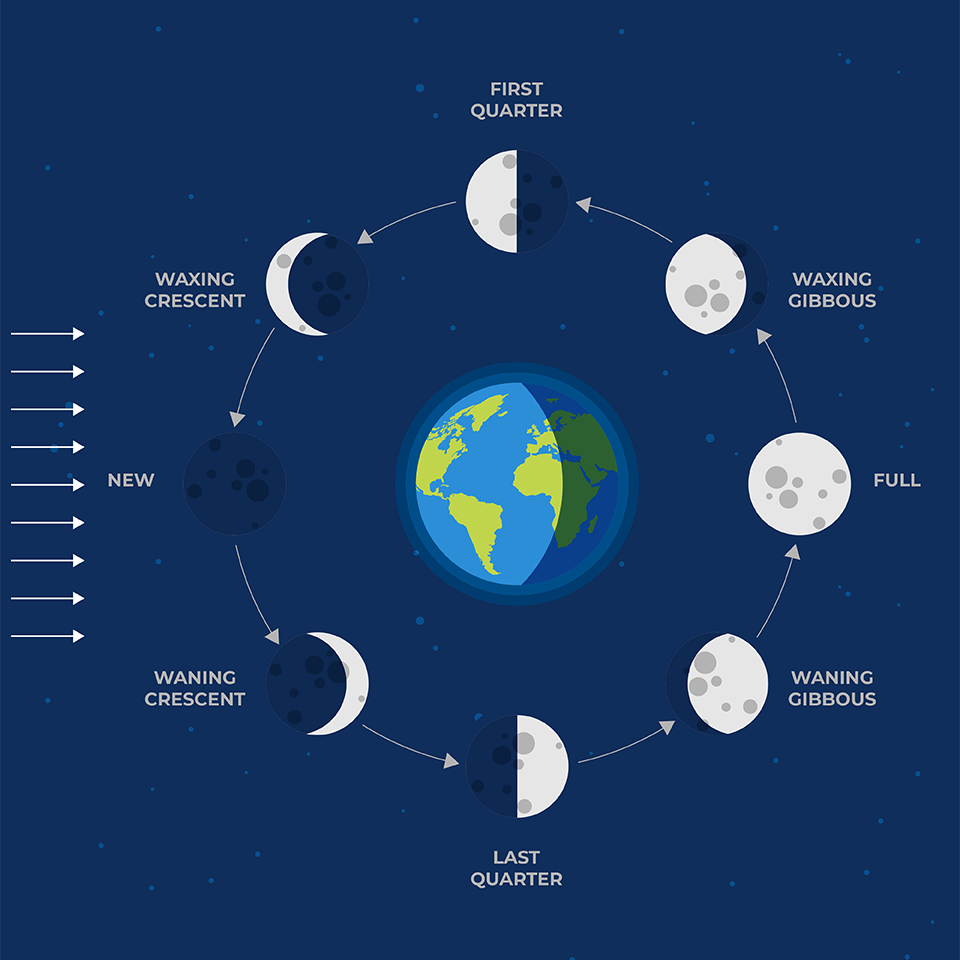
As the New Moon grows illuminated, it passes through a Crescent, then a Quarter, followed by Gibbous stage. Lastly, it reaches the Full Moon, and then the shadow starts creeping in on the other side. The cycle repeats in reverse – Gibbous, Quarter, Crescent – until we get a New Moon again.
The Moon is “Waxing” when it is growing more illuminated and “Waning” when it is growing less illuminated. A Waxing and Waning Crescent have the same shape, but they appear on opposite sides of the Moon.
It is important to point out that your location while observing the Moon from Earth is very important. The diagram above is for the Northern Hemisphere, where the moon Waxes on the right and Wanes on the left. The reverse is true in the Southern Hemisphere due to the moon appearing “upside down” by comparison.
Once you understand these basics, it will be very easy for you to tell how soon a Full Moon is to be expected! For example, if I’m in the Northern Hemisphere, and I see a Crescent Moon illuminated on the right, I know that I’m about 10 days away from the Full Moon. But if I see a Crescent Moon illuminated on the left, it will be about two and a half weeks before the next Full Moon.
Of course, that’s just a quick way to get an estimate. You can always use excellent apps to not only calculate the exact Moon phase on a given day, but also determine its position in the sky at different times of the day in your location! We will go through the most useful apps that I personally use further down in this article.
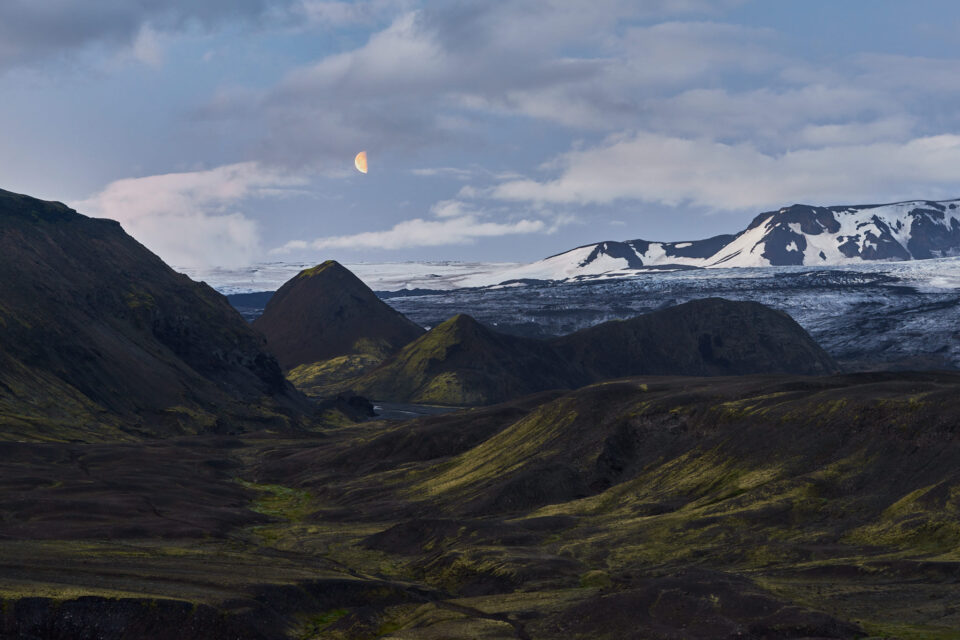
NIKON D800E + AF-S NIKKOR 70-200mm f/4G ED VR @ 90mm, ISO 100, 0.6 sec, f/8.0
Here are some other useful points of information about how the Moon looks at different times:
- The Moon is tidally locked to Earth, meaning that we only ever see one side of the moon, no matter the time of day, time of year, or your location on Earth.
- The distance from Earth to Moon varies throughout the year. When the Moon is closest to Earth, it is often referred to as the “Supermoon”. When the moon is is the furthest away from the Earth, it is referred to as “Micromoon”. More on the Supermoon below.
- If there is more than one Full Moon in a month, it is referred to as the “Blue Moon”.
- When the Sun, Earth and Moon line up, an eclipse occurs. It’s a Solar Eclipse when the Moon is blocking out the Sun (this is the more famous type of eclipse), while it’s a Lunar Eclipse when the Earth’s shadow falls on the Moon.
- The Moon during a Lunar Eclipse is often referred to as the “Blood Moon” due to its red appearance.
- In the Northern Hemisphere, the Moon’s illumination moves from right to left. In the Southern Hemisphere, the illumination moves from left to right. If you stand in the equator, the illumination will vary depending on the time of the day, as explained here.
If you want to find out the current moon phase, take a look at this page, courtesy of TimeandDate.com, where you can find out what phase the moon is currently in. You can also calculate what it will be by picking the date from the bottom of the page. Other apps can do this as well, which we will go over later in this article.
What is a Supermoon?
A Supermoon is a name given to a somewhat rare event – when the Full Moon is physically near its closest point to our planet. The term “Supermoon” can also refer to the New Moon as well, although that is not as common to see in popular media.
As the Moon rotates in its elliptical orbit around Earth, there are two points that astronomers marked with names. “Lunar Perigee,” which is the the point of the closest distance of the Moon to our planet at 363,104 kilometers, and “Lunar Apogee”, which is the point of the farthest distance of the Moon from our planet at 405,696 kilometers.
So, when Lunar Perigee coincides with the Full Moon (which normally happens several times a year), the “Supermoon” is born. It can appear up to 14% larger in diameter than a Full Moon at the Lunar Apogee, as well as having a 30% brighter illuminance. NASA’s illustration below demonstrates the appearance of a Supermoon:
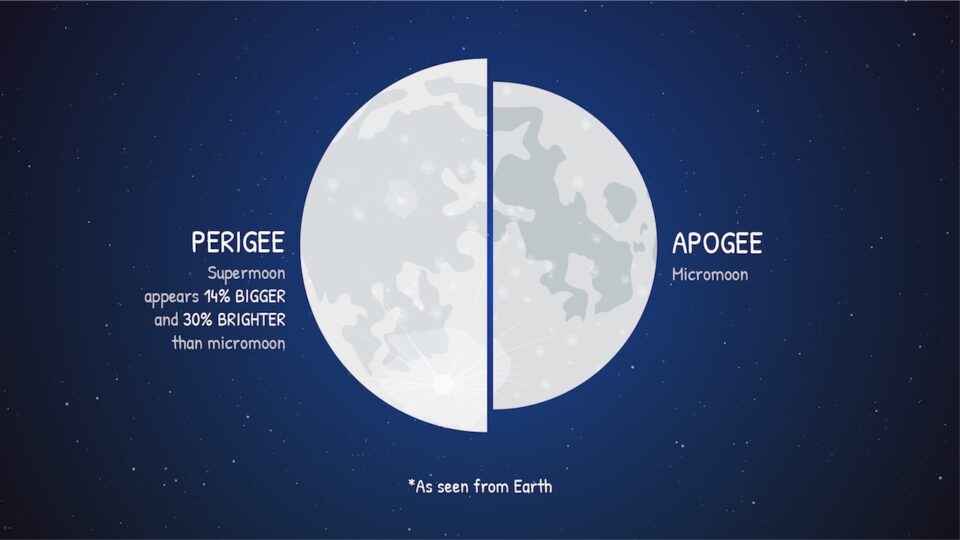
Illustration by NASA, Public Domain
Although the Supermoon can be seen several times a year, only one of those is usually the most “super” – in other words, the largest and closest of them all.
What is a Lunar Eclipse?
A Lunar Eclipse occurs when the Sun, the Earth and the Moon are closely aligned and the Moon falls into the Earth’s shadow. A Lunar Eclipse can only take place at night, and only when the Moon is Full. It can occur between two and five times a year across the world, so it is considered to be a somewhat rare astronomical event.
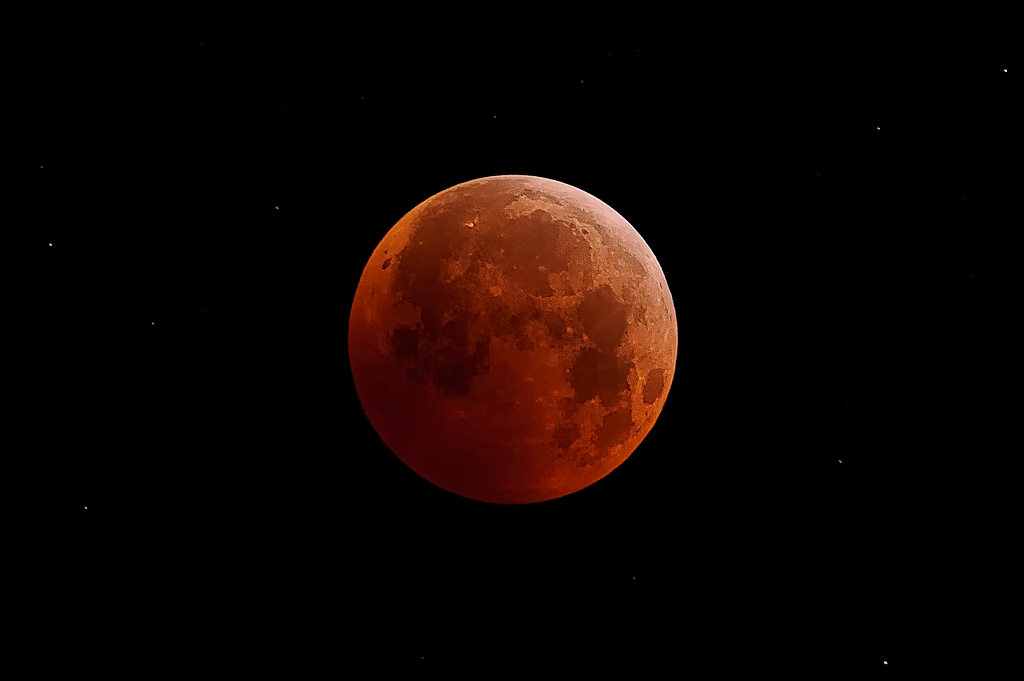
Due to sunlight passing through the Earth’s atmosphere and reaching the Moon, the Lunar Eclipse generally has a red or copper color. The amount of redness depends on the amount of dust and clouds in the Earth’s atmosphere. More atmospheric particles means a darker shade of red for the moon.
Because of this reddish color, many refer to Lunar Eclipses as the “Blood Moon” or “Blood-Red Moon.”
Full Moon Names
The Full Moon has different names depending on the month, given by Native Americans (some sources indicate the Full Moon names also originating from Anglo-Saxon and Germanic roots). Below are the names of the Full Moon by month, taken from this source:
- January: Wolf Moon
- February: Snow Moon
- March: Worm Moon
- April: Pink Moon
- May: Flower Moon
- June: Strawberry Moon
- July: Buck Moon
- August: Sturgeon Moon
- September: Harvest or Corn Moon
- October: Harvest or Hunter’s Moon
- November: Beaver Moon
- December: Cold Moon
Pop science media often goes crazy with these names. The Full Moon that occurred on January 20th, 2019 was dubbed “Super Wolf Blood Moon.” The word “super” indicated the Moon’s proximity to Earth, as explained above. The word “wolf” simply indicated the month of January. And finally, the word “blood” described the Lunar Eclipse.
Now how would you describe a click-bait title for a Lunar Eclipse that takes place in December? It would be a “Cold Blood Moon”. If the Moon is closer to the Earth, add the word “Super” in front to make it sound even more dramatic!
Unfortunately, such crazy titles are now common to see in science media…
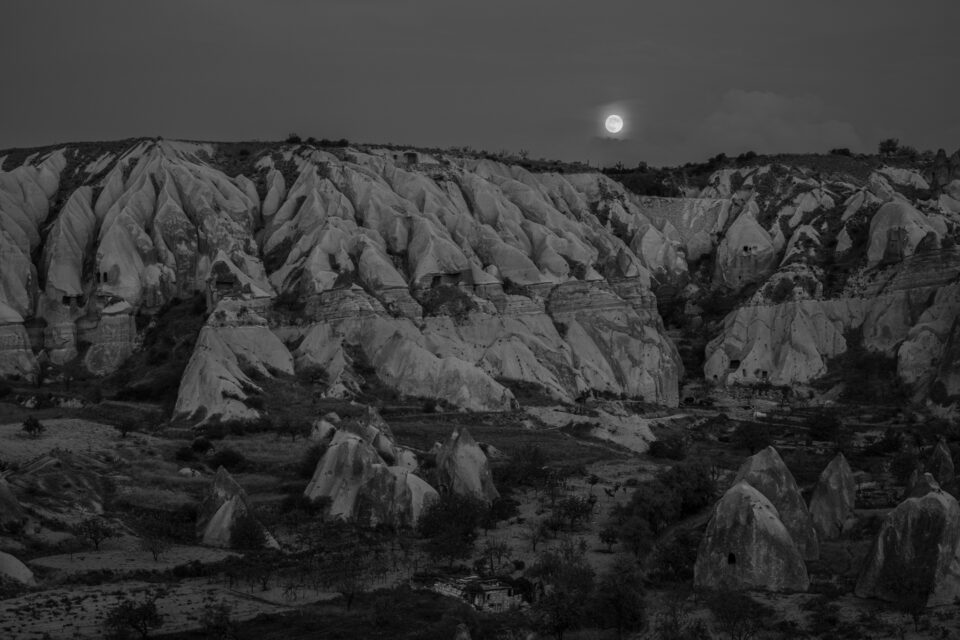
NIKON Z 7 + NIKKOR Z 24-70mm f/4 S @ 70mm, ISO 64, 5 sec, f/11.0
Moon Photography Basics
Now that we have gone through the Moon Phases and the different names of the Moon, it is time to take a look at some of the basics of how to photograph the Moon. Below is a quick summary of all the important points:
- Decide on Close-up vs with Foreground– First of all, you should decide whether you want to photograph a close-up of the Moon with all of its details, or perhaps just include it as a smaller part of your overall composition. The latter is relatively easy and does not require any special equipment. However, photographing close-ups of the Moon requires more advanced gear and camera technique. We cover all that later in this article.
- Consider Moon Phases – You will need to decide which phase of the Moon you want to capture. The Moon looks very different across its phases, casting deeper shadows on the surface and making different parts of the Moon appear more prominent. A full Moon is quite popular among photographers, but as I demonstrate further down in this article, it is not always an ideal phase to photograph due to its “flat” appearance.
- Plan – Without a doubt, planning is one of the most important steps in moon photography. If you plan it all right, you will end up with stunning images of the Moon. Proper planning is especially important for rare lunar events, because you do not want to miss the opportunity! Things like moon phases, weather conditions, location of the moon relative to your subject, camera gear, and camera settings are all important. You should take the time to assess each variable beforehand.
- Assess Camera Gear – You will need carefully assess your camera gear and see what type of moon photography you can do with it. Camera gear is important for moon photography, which is why we will cover it extensively in this article.
- Choose Proper Camera Settings – It is important to know which camera settings work best for moon photography, especially when using long super telephoto lenses and telescopes. Long shutter speeds and camera shake can be huge sources of problems, making the Moon and its details appear blurry.
- Take Time to Post-Process – The Moon might appear very flat without any post-processing, especially when shooting in RAW format, so basic post-processing is often needed. To be able to showcase all the details of the Moon and make it look sharp, you might need to use different blending, stacking and sharpening techniques in post-processing as well.
- Be Careful When Doing Composites – If you decide to give an image some artistic freedom and create a composite image from completely different sets of images, try to avoid making your images look fake. If you shot a landscape with a wide-angle lens and copy-pasted a huge version of the Moon, it will look very fake and unrealistic.
The same goes for the shadows. The dark side of the Moon should always match the brightness and the color of the sky, in both daylight and night-time conditions. So if you copy-paste the image of the Moon with its shadow looking black into a blue sky, it will obviously look fake.
Let’s go through each of the above in more detail.
How to Photograph the Moon with Foreground
If you want to take a picture of the Moon with foreground as part of your composition, you can do that very easily without any special equipment in daylight conditions. In fact, you can even capture such images even with a smartphone!
Capturing the Moon in Daylight Conditions
Capturing the Moon in broad daylight is easy, because both the Moon and the surrounding environment are equally bright, so you can capture the two in a single exposure. No special settings are needed either – just shoot in any mode hand-held, and you should have great results!
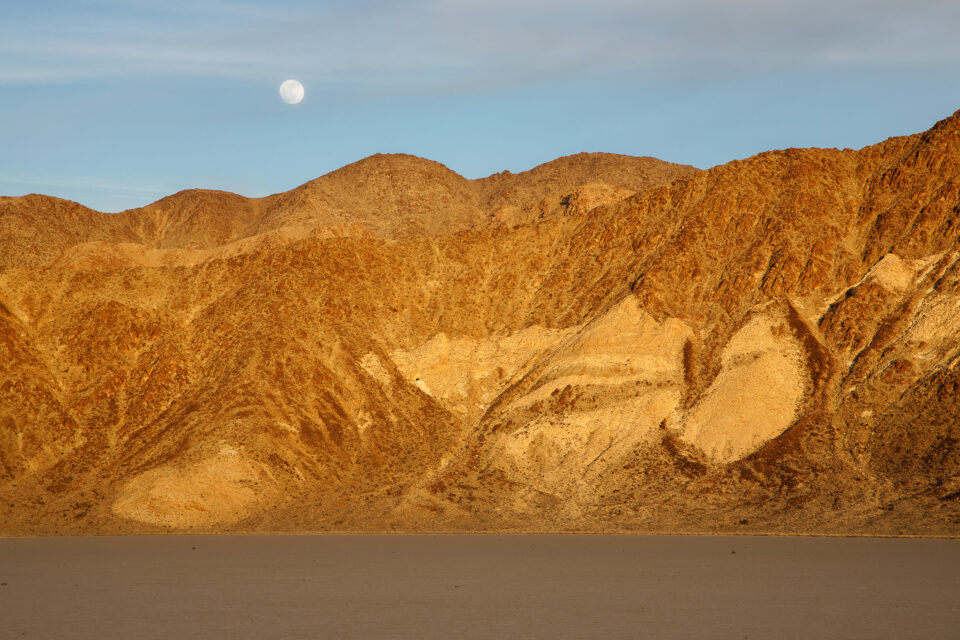
It is important to point out that when using wide-angle lenses, the Moon will appear tiny in the frame. If you want to make the Moon appear larger, you will need to use the lens’ optical zoom. However, this will also affect the rest of the frame, since everything else will also get bigger. In such situations, you might need to find a different composition to make it work, as I have done with the image above.
While some photographers resort to copy-pasting a larger version of the moon to their wide-angle shots, I recommend against such practices. That’s because such shots often end up looking fake and unnatural.
Capturing the Moon in Low-Light Conditions
What about photographing the Moon in low-light conditions? That’s when things get a bit more challenging. The main reason is differences in exposure. The Moon gets quite bright, especially when it is full, while the rest of the scene is too dark.
If you expose for the Moon, you will be able to see all the features of it, but the landscape will look too dark. If you expose for the foreground, the landscape will appear too dark and the Moon will be very overexposed.
The solution is to take two or more images, exposing separately for the Moon and the foreground, then merge the two in post-processing, as I have done in the image below:
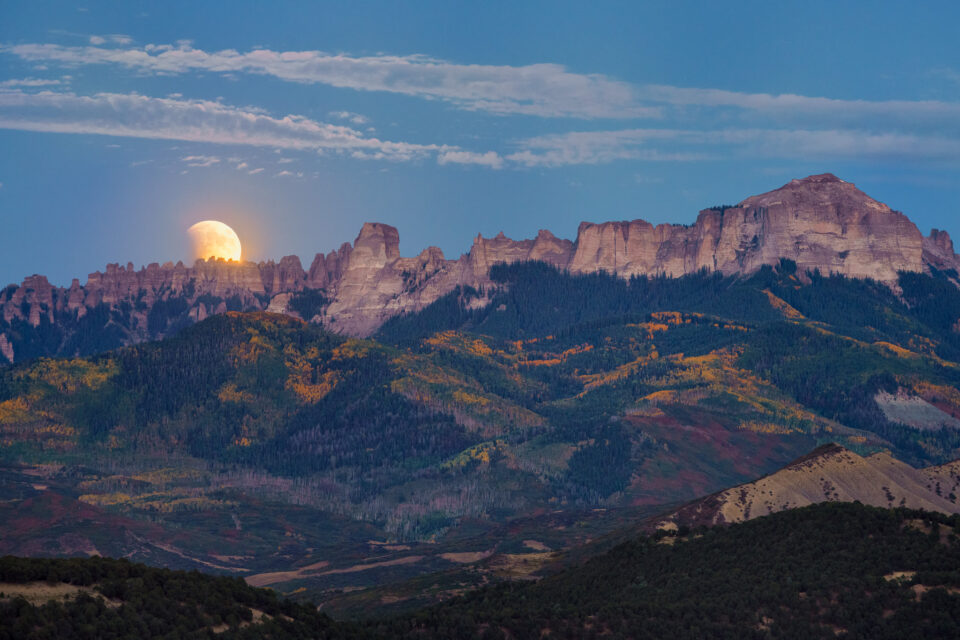
Sony A7R II + 70-200mm f/4G OSS @ 200mm, ISO 800, 0.6 sec, f/8
If your goal is to capture the Moon with the night sky, things could get a bit more challenging, since the exposure time for the sky is vastly different compared to the Moon.
If the Moon is not full and appears relatively small in size compared to the rest of the landscape (when using an ultra-wide angle lens), you could end up getting a shot like this:
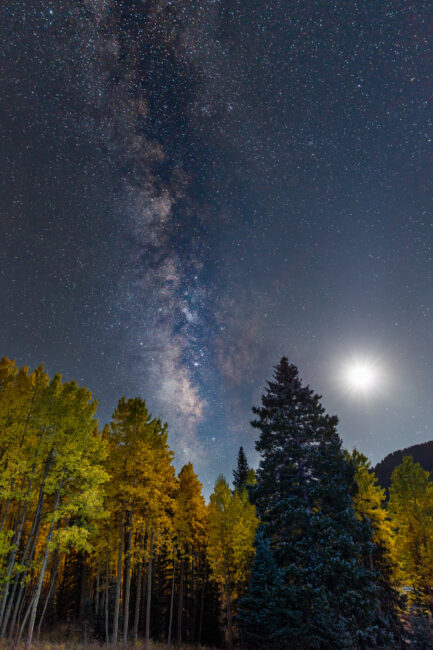
Canon EOS 5DS R + 24-70mm f/2.8L II USM @ 24mm, ISO 3200, 20 sec, f/2.8
However, attempting to shoot and then blend such images can be quite difficult in post, since the Moon can do all sorts of damage to your photograph – from visible signs of ghosting and flare, to huge parts of the sky appearing too bright. If the Moon is full or near full, you might not even be able to capture most of the stars, especially if there is dust, moisture, or other particles in the atmosphere.
Photographing Close-Up of the Moon
Taking a detailed close-up picture of the Moon can be difficult, depending on how big you want it to appear and how much detail you want to showcase. An extreme close-up of the Moon requires a long super telephoto lens, or a telescope attached to a high-resolution digital camera, as discussed below.
In addition, you will need to do proper weather and location planning for photographing a close-up of the moon. Your best option might be to get out of town and travel to a remote location with very little light and air pollution, preferably at a higher elevation.

Nikon D300 + 200-400mm f/4 + 1.4x TC @ 560mm, ISO 200, 1/250, f/5.6
Weather planning is especially very important, as discussed in the next section. You do not want to deal with atmospheric haze due to dust, smoke and moisture in the air, and you certainly do not want to deal with any heat waves either. These things destroy the structure of the moon, making it very difficult to preserve any details.
Basically, the less the distance and substance between you and the Moon, the better the results.
In this article and further steps, we will mostly focus on photographing the Moon close-up.
Moon Phase Considerations
While most photographers strive to capture the Moon when it is full, keep in mind that when the Moon is fully illuminated by the Sun from our perspective, its surface features disappear due to lack of shadows. This results in the Moon looking very “flat”, as you have probably seen in many pictures like this before:
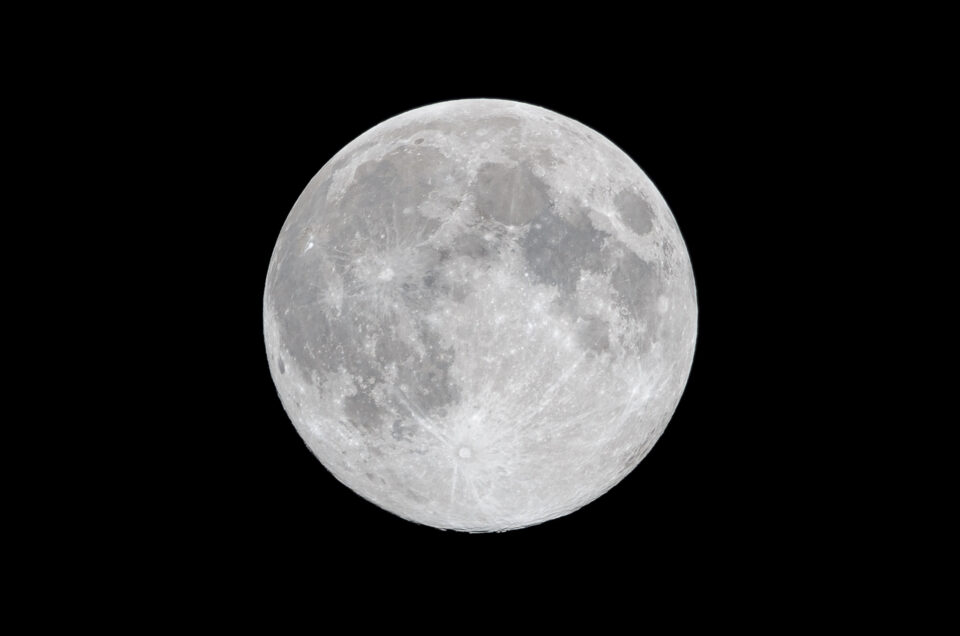
NIKON D7000 + 400mm f/2.8 + 1.7x @ 680mm, ISO 100, 1/400, f/4.8
If you have never photographed the Moon before, I would certainly suggest to take a picture of it when it is full. You will learn quite a bit in the process and you will have a picture of the Full Moon that you can reuse in other images.
However, once you capture the Full Moon, I would recommend to try shooting it during other phases. You will see just much difference there is in surface-level detail between different phases and you will notice things you might have never seen before. Craters and mountains of the Moon appear differently during different phases, making the images look more interesting.
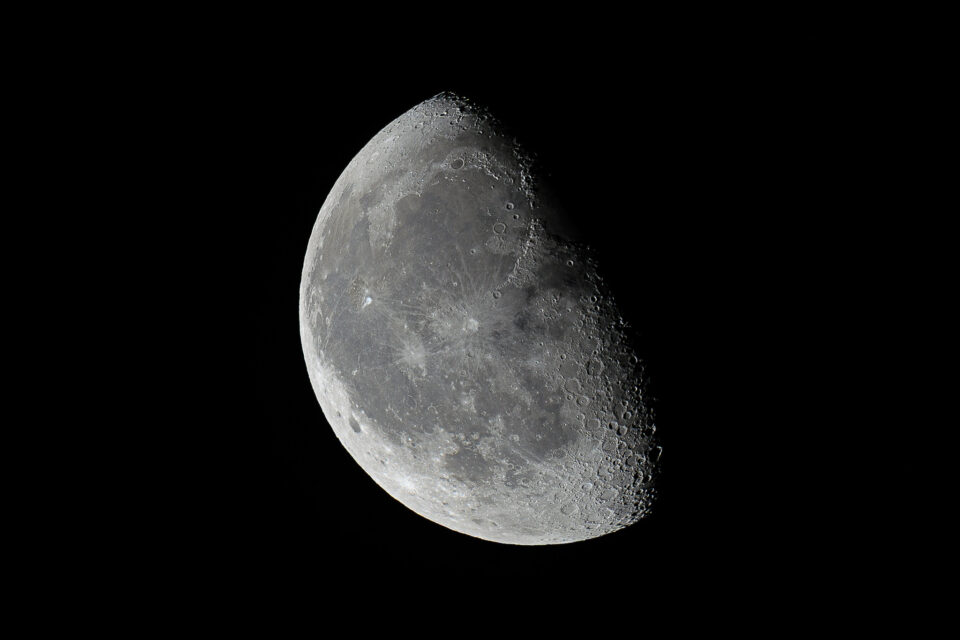
NIKON Z 7 + 600mm f/4 + 1.4x TC @ 850mm, ISO 64, 1/125, f/6.3
Once you pick the Moon phase, the next step is to properly plan the shot.
How to Plan for Photographing the Moon
Proper planning is very important if you want to end up with a beautiful image of the Moon. If there is a rare event, such as a Supermoon, a Lunar Eclipse, or a combination of different lunar events, you might need to take a bit more time to organize and plan.
As we explain in the article, the process of photographing a Lunar Eclipse is very different, requiring a lot more technical skill to obtain a solid image, which is why proper planning and prior testing are necessary. An ultra-rare event such as a Solar Eclipse is even more demanding, and if you are not careful, you could end up damaging your camera gear and even your own eyesight!
Check Weather Forecasts
It goes without saying that you should be watching weather forecasts to make sure that the part of the sky where the Moon will appear is going to be clear. While photographing the Moon with some clouds could be fun when doing a wide-angle shot, you certainly do not want to deal with heavy clouds, haze or moisture in the atmosphere when shooting extreme close-ups.
High levels of haze and moisture in the atmosphere can be particularly damaging, as they can blur the details of the moon and make it appear blurry.
Also, if you live in a large city, air pollution can be a big problem, especially on hot summer days. Heat waves are a definite problem when shooting at long focal lengths, as can be seen from the image crops below:

I personally find colder nights to be ideal for close-up moon photography for this reason. However, cold temperatures make it difficult to stand for prolonged periods of time outside and drain camera batteries faster.
Use Apps and Websites for Planning
Take advantage of useful apps and websites to figure out when the targeted Moon phase occurs, when the Moon rises and sets and where you can photograph it from. Some apps even have a “Night Augmented Reality Mode” that overlay the moon on your landscape / subject to calculate the precise time and location.
Here are some useful online resources I personally use for moon photography:
- TimeAndDate.com Moon Phases – a great resource to find the current moon phase, as well as other upcoming lunar events.
- Dark Sky Finder – I use the Dark Sky Finder map to find the best spots in my area with the least amount of air pollution.
When it comes to apps, there are many to choose from, but these are the two I personally recommend over others:
- The Photographer’s Ephemeris 3D – a solid app that shows a lot of useful information for moon photography. The 3D view is very helpful for planning.
- Photo Pills – my personal favorite. I use Photo Pills all the time to look up Moon phases. I am particularly a big fan of the Augmented Reality (AR) mode.
On location, make sure to use apps similar to the above to figure out exactly where the Moon will appear relative to your foreground / subject if you are planning to incorporate it to your images to improve your composition.

The Augmented Reality feature on the Photo Pills app, in particular, is very useful for proper planning. You can stand in the exact location where you want to take a photo, then move the timer to the date and time the Moon will be in the phase you want, and it will show you how the Moon will move relative to the landscape you see through your device’s camera.
Work on Composition
If your plan is to photograph the Moon with an interesting foreground or a subject in the scene, then you must pay close attention to your composition. The type of composition you use will depend on the size of the Moon relative to the foreground.
When shooting a scene with a wide-angle lens, the Moon is going to take a very small portion of the scene. In such cases, the Moon is often going to take on the role of a filler element that adds something interesting to the image.
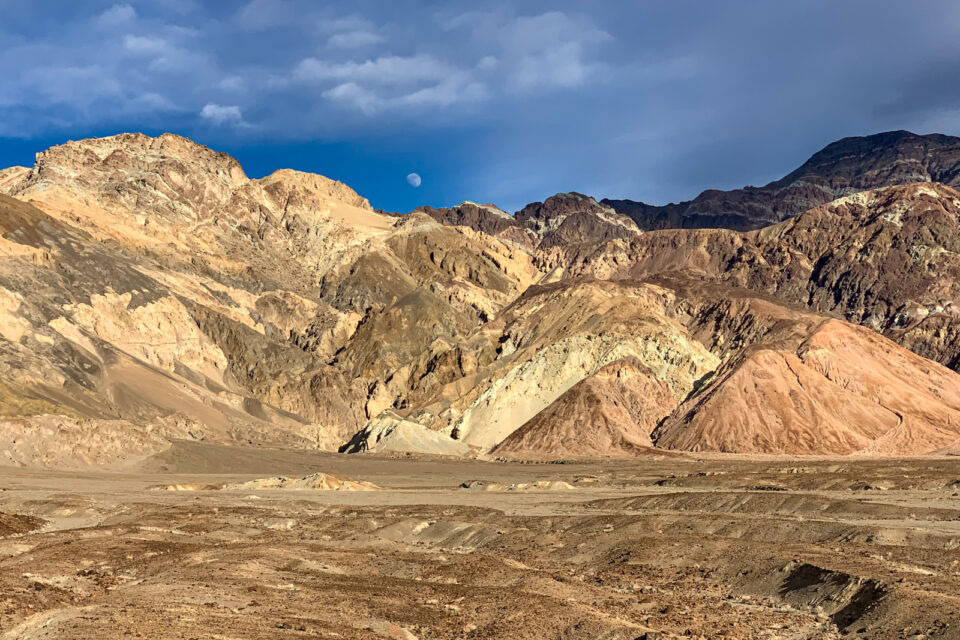
iPhone XS Max @ 6mm, ISO 16, 1/1150, f/2.4
However, if you use a telephoto lens to make the Moon appear much larger, it will often become the primary or the secondary subject in the frame. In such cases, the Moon is the highlight and the rest of the scene is there to help show the essence and the beauty of the Moon.
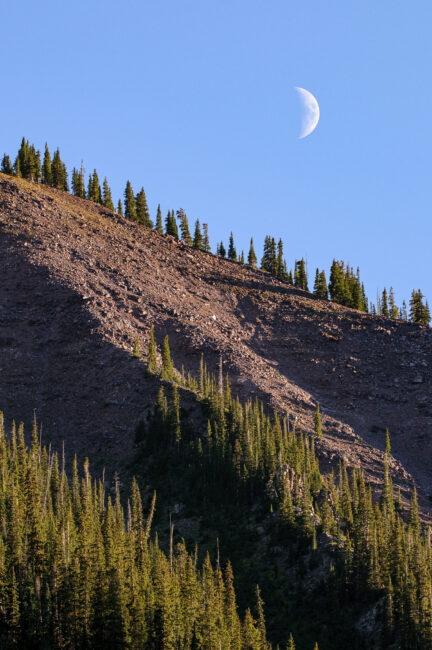
NIKON D300 + 200-400mm f/4 @ 200mm, ISO 200, 1/500, f/5.0
Prepare Camera Gear and Test
Once you scout the location, find out exactly where the moon will rise and set, you can prepare your camera gear and test it out (the camera gear and all the camera settings are going to be covered next). Once you get it all ready to go, make sure to test the camera gear and the settings beforehand.

If you are photographing just the Moon without any special lunar events, then you can test your setup any time, since you will have plenty of it. However, if you are anticipating an event like a Lunar Eclipse, you should prepare in advance and read this article in detail. Extremely rare events such as the Solar Eclipse require much more planning. See my article on How to Photograph a Solar Eclipse for detailed information.
Best Camera Equipment for Moon Photography
Not all cameras and lenses are ideal for all types of moon photography. If you have a smartphone or a basic digital camera with a wide-angle lens, you will be limited to photographing the Moon as part of your composition.
Those equipped with compact cameras with high-power zoom lenses, interchangeable lens cameras with super telephoto lenses, or digital cameras mounted to advanced telescopes will be able to capture the Moon in its full glory, with a lot of close-up detail.
Others might even take advantage of equatorial trackers that can automatically track the Moon across the sky, yielding maximum image quality while providing convenience in the field.
Camera and Lens
There are many different types of cameras, lenses, telescopes and mounts available out there and we cannot go over them all. However, below is a list of basic camera gear that you will need to photograph a close-up of the Moon:
- An interchangeable lens camera with a 300mm+ telephoto lens (in full-frame / 35mm equivalent), or a point-and-shoot camera with a high-magnification optical zoom lens.
- A stable tripod.
- Remote camera release (optional). If you do not have one, a timer in your camera should also work.
If you want to enlarge the moon and show the details of its surface, a high-quality telephoto lens with a focal length of 300mm+ is needed. The longer the lens, the better.
If your lens can be coupled with teleconverters, I highly recommend adding one to increase the overall focal length. For example, a 1.4x teleconverter will increase the focal length of a 300mm lens by 40% or to 420mm total, while a 2.0x teleconverter will increase the focal length of the same lens to 600mm.
The only thing to keep in mind, is that teleconverters negatively impact lens sharpness and decrease its maximum aperture. For example, if you mount a 1.4x teleconverter to the Nikon 300mm f/4 PF lens, it will essentially become a 420mm f/5.6 lens. Due to significant loss of sharpness when using 2.0x teleconverters, I recommend against their use for moon photography.
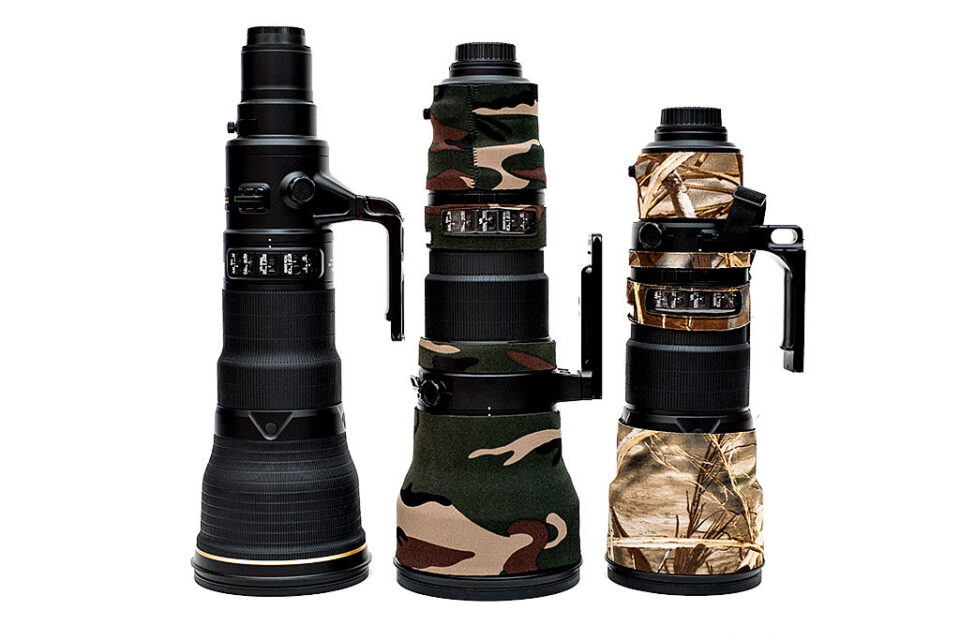
Since super telephoto prime lenses are typically very costly, I would recommend to use good quality zoom lenses instead. Lens manufacturers like Sigma and Tamron offer zoom lenses in the 150-600mm range that are excellent candidates for photographing the moon. Nikon’s 200-500mm f/5.6E VR is also a great choice, giving you plenty of reach at 500mm.
Speaking of “reach”, a smaller-sensor camera is often more preferable than a full-frame camera. This is due to smaller sensors having smaller pixels and lots of resolution, allowing for more magnification of the subject.
For example, if you were to compare the Nikon D3500 to the Nikon D750, both have similar 24 MP resolution. However, the former is a DX camera with an APS-C sensor, while the latter is an FX camera with a full-frame sensor (see FX vs DX). This means that the D3500 is going to have a 1.5x more magnification and a much smaller pixel pitch, making the Moon appear larger in the frame.
So in this particular case, the D3500 is going to be more preferable than the D750 to get a close-up of the Moon. Keep this in mind when evaluating cameras for moon photography. A cheaper, smaller sensor camera might be a better choice at the end of the day!
If an interchangeable lens camera with a telephoto lens is out of your budget, consider getting a point-and-shoot camera with a high magnification zoom lens such as the Nikon P900. Thanks to its insane 24-2000mm full-frame equivalent lens, the Nikon P900 is one of the best cameras on the market for moon photography today. With its price tag of $600, it gives expensive super telephoto lenses a run for its money!
Now if you want the best setup for photographing the Moon, consider getting a high-quality telescope with a digital camera mount. While a basic telescope with a small digital camera might end up costing you less than a high quality telephoto lens on a DSLR or a mirrorless camera, an advanced telescope with an equatorial mount coupled with a properly cooled CCD sensor camera will cost a fortune.
Dedicated astrophotographers who like taking pictures of deep sky objects use such gear and they can photograph extreme details of the lunar surface. Unless you know what you are doing, I would recommend against building a telescope rig, as it can get complex to set up and shoot.
Tripod and Accessories
When using long focal length lenses, camera shake becomes a big problem. As long focal lengths go beyond 300mm, even a slight move can mess up and blur the picture. That’s why if you are using a telephoto lens, a stable tripod is required to be able to produce a sharp image of the moon.
If you shoot with a very long lens, you should totally read my advanced article on how to stabilize your tripod. Trust me, you will need every tool in your arsenal to make a blur-free image of the moon at focal lengths above 300mm, especially if you have a shaky tripod or unstable tripod head.
In addition to the tripod, you will need a solid tripod head that makes it easy to readjust the camera position when the Moon moves. Keep in mind that the Moon moves a lot, especially at higher magnifications, so you will be constantly adjusting your camera to keep the moon centered.
Despite my typical recommendation to use a solid ball head, I recommend against using one for photographing the Moon. Instead, use a geared 3-way Pan-and-Tilt head, as it will be easier to adjust it to a precise position. The heavy-duty geared head I recommend is the Manfrotto 405, but if you are using a lightweight setup, the Manfrotto 410 is significantly cheaper.
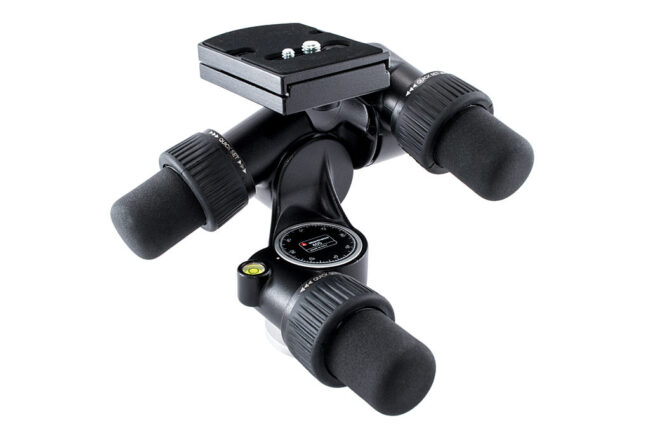
Having a remote camera trigger also helps reduce the camera shake. If you shoot with a DSLR, you can use the Mirror Lock Up (MLU) feature together with a remote camera trigger to reduce mirror vibrations.
Equatorial Tracker
You don’t really need an equatorial tracker for photographing the Moon, because it is bright enough to use fast shutter speeds and low camera ISO values.
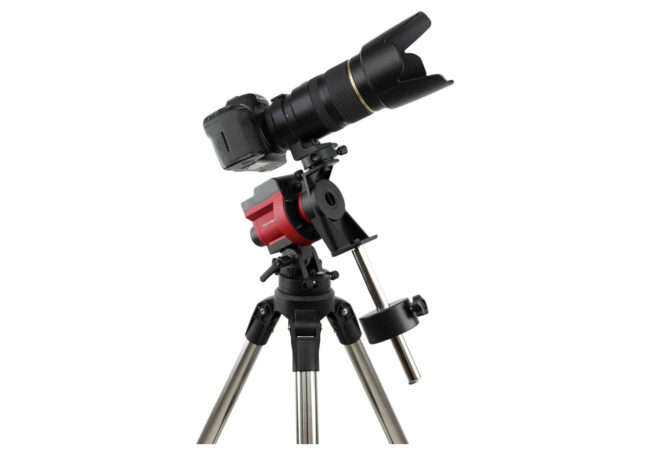
Still, if you use long lenses and you do not want to deal with having to constantly adjust the tripod, an equatorial tracker can come quite handy. If you want to buy one for your astrophotography needs, I would recommend to go with the iOptron SkyGuider Pro. It is a very solid tracker that is easy to use. Once you align the unit with the North Star, the rest is a breeze!
Best Camera Settings for Photographing the Moon
To photograph just the moon by itself, without any objects in the foreground, you will need a long telephoto lens like explained above to magnify the moon and try to fill as much of the frame as possible. With your telephoto lens mounted on your camera, secure the two on your tripod and point at the moon. When it comes to camera settings, including shutter speed, aperture and ISO, here is what I recommend for general use:
- Image Format: If your camera can shoot in RAW image format, choose RAW instead of JPEG. This way, you do not have to worry about your camera settings affecting your images, including White Balance.
- Camera Mode: Set your camera mode to full manual mode.
- ISO: Set your ISO to your camera’s base ISO, which is typically ISO 100 on most cameras. If you have a point and shoot camera, see if you can find a menu setting to set your ISO to 100. Make sure “Auto ISO” is turned Off.
- Aperture: Set your aperture to f/11.
- Shutter Speed: Set your shutter speed to 1/100.
- White Balance: Set it to “Daylight”, although it does not matter if you shoot in RAW – you will be able to change it in post-processing.
- Lens Focus: Use the rear LCD screen of your camera to zoom in and focus on the moon. Once focus is acquired and the Moon appears sharp, make sure to set your lens to manual focus to prevent your camera from refocusing.
- Image Stabilization: Turn it off, since you are shooting from a tripod.
- Camera Shake: To reduce vibrations from the mirror mechanism on a DSLR, make sure to use Mirror Up mode. To reduce vibrations from the shutter mechanism (both DSLR and mirrorless cameras), make sure to turn Electronic Front Curtain Shutter on.
The above aperture and shutter speeds are derived from the Looney 11 rule, which is not necessarily very accurate for moon photography, as I explain further down below. I recommend starting with the above settings and adjusting the shutter speed based on the brightness of the moon.
If it is too bright, set your shutter speed to a higher value. If it is too dim, set your shutter speed to a lower value. Remember, the moon moves pretty fast, so you definitely do not want to be photographing it with a slow shutter speed, especially when using a long telephoto lens. If your shutter speed is too slow, you can open up the lens aperture or increase the camera ISO.
Another thing I recommend is to bracket your shots. When taking pictures of the Moon, you might notice that some parts of the moon come out overexposed, while other parts are quite underexposed. To prevent such issues, you can bracket your shots full stop apart – I would recommend at least three exposures to be on the safe side. You can then use post-processing techniques like HDR to merge these images into a single one.
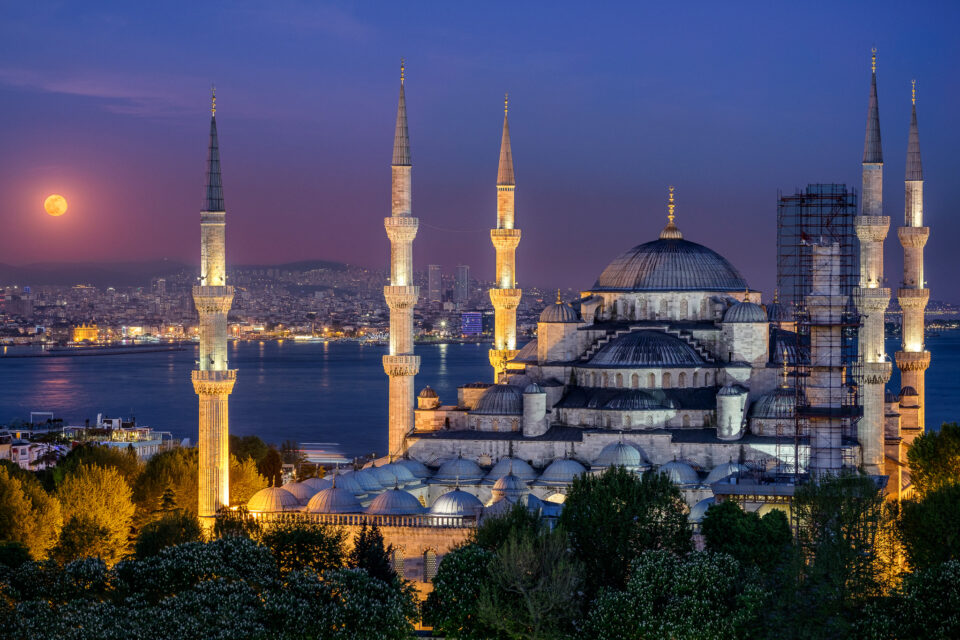
Fuji X-Pro2 + XF56mmF1.2 R APD @ 56mm, ISO 200, 1/8, f/5.6
Modern DSLRs and mirrorless cameras come with a feature called “Electronic Front Curtain Shutter“, which can completely eliminate shutter shock. If you have this feature on your camera, make sure to enable it from the camera settings, as shown below:
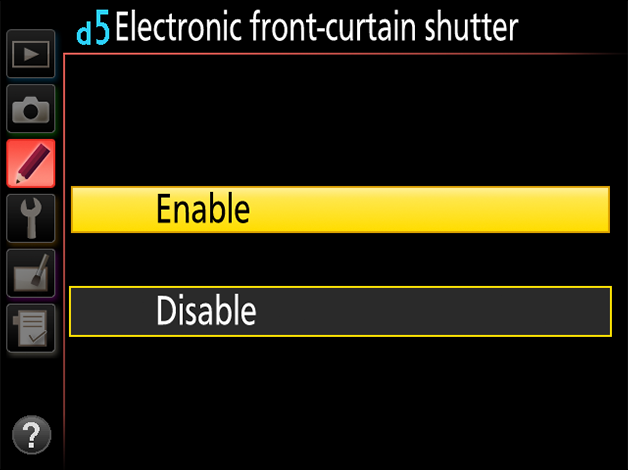
If you do not have a remote shutter release cable or device, set your camera to a timer. The idea is to eliminate camera shake caused by your hands and the mirror slap before the exposure.
If you shoot with a telephoto lens longer than 300mm, it is best to enable Exposure Delay mode in combination with the timer. If you have a remote shutter release cable or device, then a timer is not necessary, but I would still turn Exposure Delay on to prevent mirror slap from potentially causing camera shake.
Lastly, set your camera’s metering mode to spot, keep the focus point on the Moon and watch your metering indicators. If you see over-exposure or under-exposure on the moon, adjust your camera settings accordingly.
How to Focus on the Moon
If you are using a DSLR camera, it is best to use the “live view” feature to bring the image from the image sensor to the back LCD. Once in live view, the next step is to zoom in to the Moon as tight as possible, then use your camera’s autofocus system to acquire focus.
Most DSLR cameras will be able to autofocus on the moon this way. If autofocus does not work, try to put the focus point on the edge of the Moon and give it another shot. If your camera is still struggling, you might need to turn off autofocus and move the focus ring manually until the Moon looks sharp.
It is important to point out that some DSLR cameras will show the Moon as a white blob in live view. If you see this problem, the first step is to adjust your shutter speed until you start seeing the features of the Moon. If adjusting the shutter speed does not do anything and you still see a white blob, it most likely means that your camera is boosting the exposure automatically. In such cases, you will need to check out your camera’s manual in order to turn this auto boosting mode off. On Nikon DSLRs, it could be as simple as pressing the OK button.
If you use a mirrorless or a point-and-shoot camera, you do not have to go into live view mode, because the camera is already mirroring what is on the image sensor to the rear LCD. Simply zoom in to the Moon with the LCD as much as possible, then use the camera’s autofocus system to focus on the Moon, or its edges.
Once the Moon looks sharp on your camera’s LCD, make sure to turn autofocus off. You can do that either through a switch on the lens, a switch on the camera, or sometimes through a camera setting. You do not want your camera to try to re-focus each time you take a shot, which is why it is a good idea to turn it off completely.
Looney 11 and Exposure Issues
What is the correct exposure for the Moon? Remember, the Moon is illuminated by the Sun and its brightness varies by a number of different factors, such as weather conditions (air cleanliness, mist, haze, etc), phase of the Moon and its location in the sky.
If we assume that the sky is completely clear and the Moon is located high in the sky, we can use the basic “Looney 11” rule, which states that you can use the aperture of f/11, and shutter speed to the reciprocal value of ISO to get a good exposure of the Moon. For example, if you use ISO 100, the shutter speed would be roughly 1/100th of a second at f/11, while with ISO 200, it would be 1/200th of a second at the same aperture.
While you can use this math as a baseline, it does not work well in practice. The reason for that are the two variables of exposure: aperture and shutter speed. The aperture of f/11 is diffraction-limited, which means that stopping down to such a small aperture is going to hurt the sharpness of your Moon photos, especially when using cameras with smaller sensors.
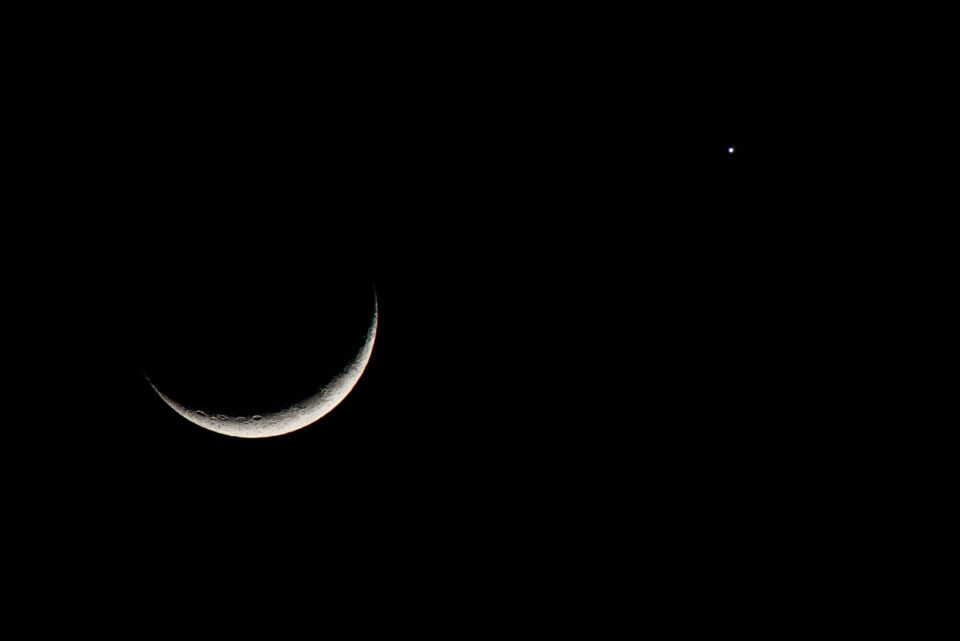
NIKON D750 + 300mm f/4 + 1.4x TC @ 420mm, ISO 400, 1/100, f/5.6
The shutter speed of 1/100 at ISO 100 can also be too slow when using long super telephoto lenses, because of potential camera, tripod, wind and other vibrations that could make images look blurry. In some cases, you might need to push ISO to higher values to get acceptable shutter speeds for your setup.
Alternatively, a better approach is to start with a larger aperture like f/5.6, which gets you started with a sharper image. This should triple the starting shutter speed as well (when compared to f/11), resulting in less potential for camera shake.
Some configurations of telephoto lenses with teleconverters require stopping down to get acceptable sharpness, so you might need to shoot in the f/8-f/11 range anyway. However, if you are not using a teleconverter with a super telephoto lens, there is little reason to stop down beyond the maximum aperture.
Keep all this in mind when photographing the Moon. Looney 11 might sound like a good starting point, but it does not really fit modern digital camera and lens standards…
How to Photograph the Supermoon
As I have already pointed out, a Supermoon occurs when the Moon is new or full, and it is at its closest proximity to our planet. If the skies are clear and you are lucky to see the Supermoon, why not photograph it?
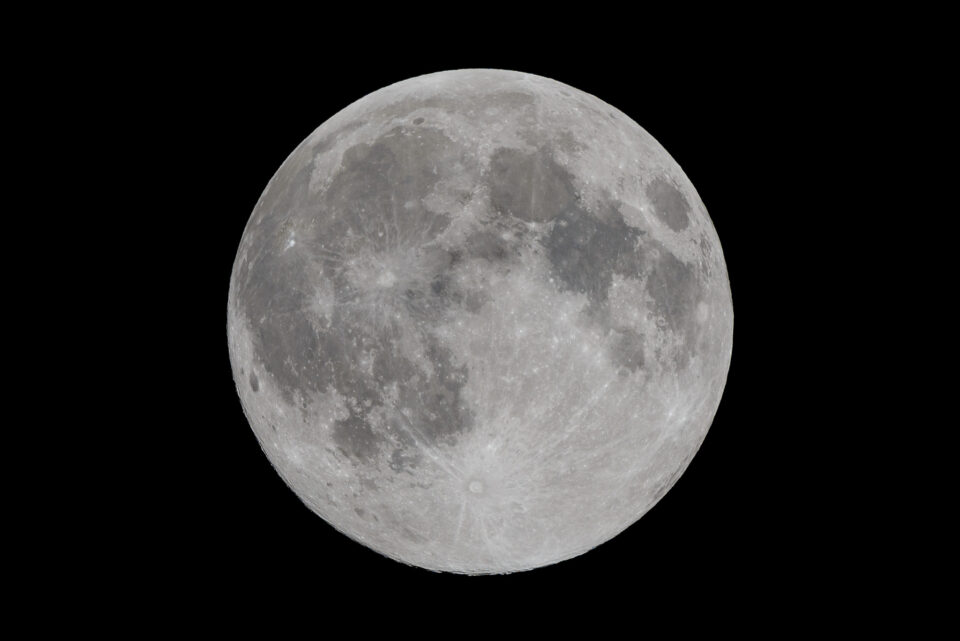
NIKON D800E + 500mm f/4 + 2x TC @ 1000mm, ISO 200, 1/250, f/13
The process of photographing the Supermoon is identical to photographing regular Moon. In fact, since the Moon is a bit larger and brighter than usual, it should be easier to photograph.
For the above photograph, I used the shutter speed of 1/250th of a second at ISO 200, which was fast enough to yield a reasonably sharp image of the Moon (there was no wind that day). I used the Nikon 500mm f/4G VR super telephoto lens with a 2x teleconverter, which resulted in a 1000mm f/8 setup. Since the lens sharpness suffered greatly due to use of a 2x teleconverter, I had to stop the lens down to f/13 to improve sharpness.
How to Capture “Earthshine”
The dark side of the Moon that is dimly illuminated by the sunlight reflected from Earth is referred to as “earthshine”. It can be photographed with your camera, provided that you expose for the shadow part of the Moon. This will severely over-expose the bright side of the moon, while showing the details of the dark side. However, if you are dealing with a very thin crescent moon, the dark side might become visible as you use a slow shutter speed, as can be seen from the image below:
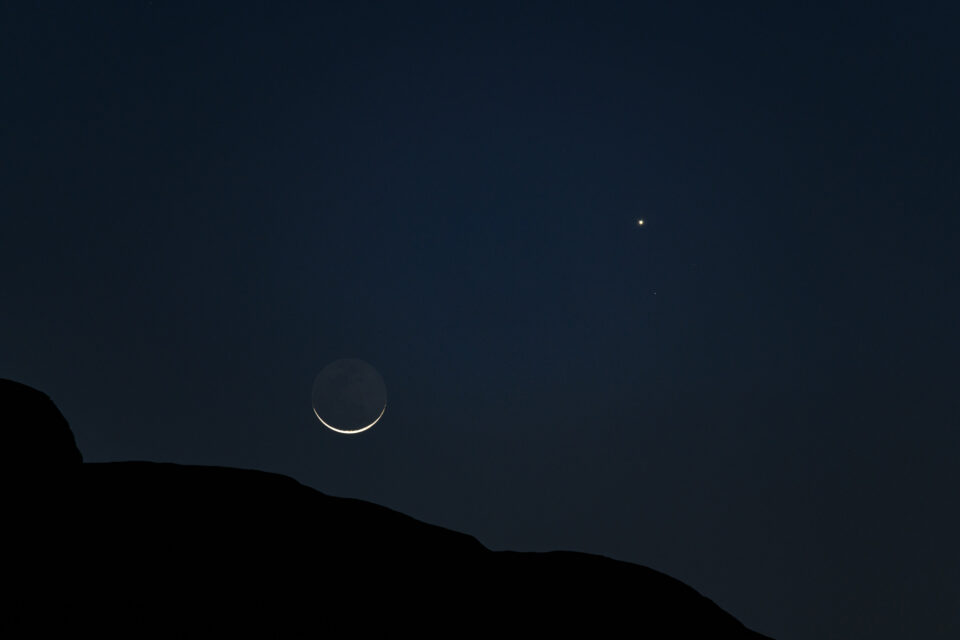
NIKON D850 + 70-300mm f/4.5-5.6 @ 300mm, ISO 400, 0.6 sec, f/5.6
In most other cases, trying to bring out Earthshine will result in the other part of the Moon appearing very overexposed. Keep in mind that such slow shutter speeds are problematic to use due to Moon’s constant movement, especially when using long lenses.
Photographing the Moon with a Phone
It is certainly possible to photograph the Moon with a smartphone or a tablet that is equipped with a camera, but you need to be aware of the limitations.
The biggest issues with using a smartphone or a tablet are precise focus and exposure control, as well as inability to zoom in tight enough to get a close-up shot of the Moon. Smartphones and tablets are typically designed with a single wide-angle lens, which is not particularly suitable for moon photography, as explained below.
How to Photograph the Moon with Your iPhone
If you have an iPhone with a single camera, you will be limited to photographing the Moon as part of your composition. That’s because iPhones with one camera are very wide in their field of view. Shooting during the day will be easy and the composition recommendations from this article will work.
However, if you attempt to capture the Moon at night with that wide-angle lens, you will end up with a small white blob. That’s because the camera will meter off your whole scene and the Moon is just way too small of a subject. In such cases, it might be best to skip trying to include the Moon in your shot.
If your iPhone is equipped with a dual camera, such as the iPhone 7 Plus, iPhone 8 Plus, iPhone X, iPhone XS, etc., then you can use the telephoto lens to capture descent photos of the Moon.
First, zoom in to the Moon as much as you can. You will see that the Moon will appear like a white blob. Next, touch the screen to focus on the Moon, then once the yellow box with a slider appears, slide down with your finger to reduce the Moon’s brightness:

You should see the features of the Moon start to appear as you do that. Take a picture once the Moon looks good.
Keep in mind that the Moon photo will look nothing like the pictures you see in this article. That’s because even with a telephoto lens and high zoom ratio, you will end up with a Moon that looks quite small.
How to Photograph the Moon with an Android Phone
Those who use Android-powered devices will have very similar challenges as iPhone users. However, typical camera apps for Android devices have more options and more precise exposure control, which makes it easier to photograph the Moon.
If your Android phone or tablet has a telephoto lens, your best bet is to use that one instead of the wide-angle lens to focus on the Moon. Use your camera’s built-in camera app to adjust the shutter speed until the Moon looks properly exposed. Make sure to reduce ISO to the lowest level and if your device has aperture control, make sure to open up the lens aperture as wide as possible.
Now if you have a telescope or a pair of binoculars that you can hold steady while pointing at the Moon, you can technically capture the Moon with any smartphone or a tablet. However, don’t expect the resulting image to look great – you will most likely see heavy amounts of chromatic aberration, as well as damaging distortions. You might also struggle with keeping the Moon in focus.
Lastly, keep in mind that there might be special accessories for smartphones that provide better zoom capabilities. Such accessories might be useful for moon photography, but don’t expect them to provide amazing results…
Exposure Differences – Case Study
Let’s now move on to how you can take a picture of the moon together with a foreground object – whether it’s a tree, a house or a large rock. As explained earlier, the moon will always look overexposed after sunset in comparison to everything else.
The only way to capture the scene with the moon properly exposed, is to take two separate shots of the scene – one with the foreground properly exposed and the moon overexposed and one with the moon properly exposed and the foreground objects heavily underexposed. Take a look at the following two shots:
As you can see, I shot the above two images in two separate exposures – one with foreground properly exposed, one with the moon. Here is the combined shot that I did in Photoshop in just 2 minutes:
The above example is not the best one in terms of subject and composition, but it gets the message across – you will need to combine two exposures to create a single image. The toughest part is to properly mask out the Moon and to transparently merge the darker edges of the moon with the blue sky, which should not be a problem if you know how to use the right tools within Photoshop. If the sky is equally dark in both frames, then the amount of time spent in Photoshop is minimal – all you would need to do is copy-paste the Moon and you are set!
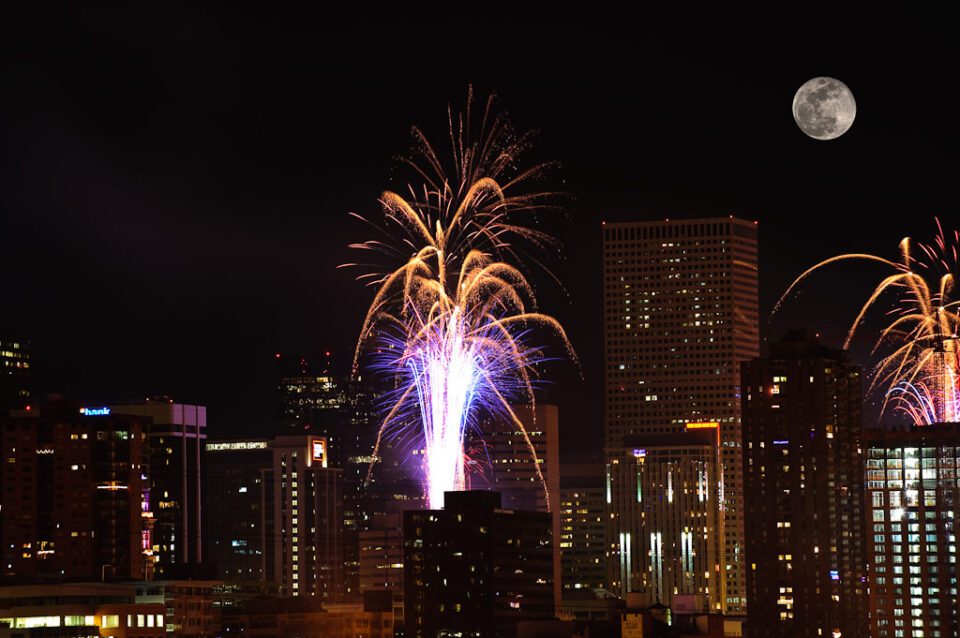
Post-Processing Your Moon Photos
No matter how good your image comes out of the camera, I still recommend doing some post-processing to enhance the look of your Moon image. Take a look at this photo of the Moon, straight out of the camera:
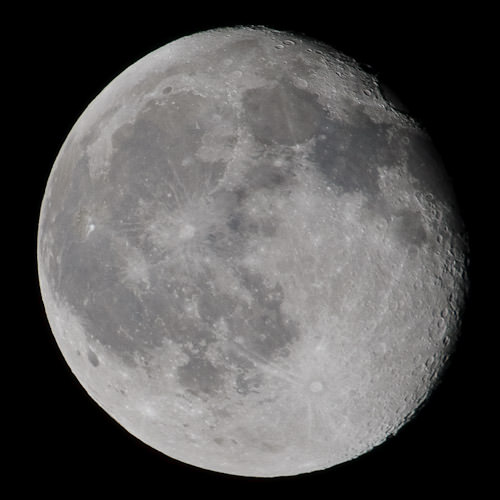
Now, take a look at this image that I enhanced in Photoshop:
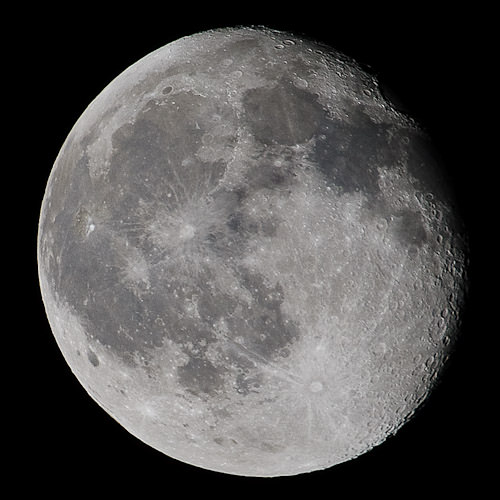
How did I do it? It was a simple, two step process:
- Image->Adjustment->Curves and selected “Medium Contrast” Preset from the drop-down menu and clicked “OK”.
- Filter->Sharpen->Unsharp Mask and added 150% in “Amount” field, while keeping the “Radius” on 1.0 pixels and “Threshold” on 0 levels.
Very simple and quick! If you are a Lightroom user, you can achieve great results with even less total clicks.
Here are some basic Lightroom adjustments I recommend:
- Start off with the right Camera Profile. I personally find “Camera Landscape” profile for my Nikon DSLR and mirrorless cameras to work the best for the Moon.
- Adjust White Balance. Start with Daylight white balance and if the Moon is too orange, move the Temperature slider left.
- Adjust Contrast between 10-20.
- Don’t reduce Highlights too much, or the features of the Moon might start to disappear and the image will turn too dark. My recommendation is to stay under -15.
- The same with the Shadows – don’t increase it too much, or you will start making the image look too flat.
- To boost contrast even further, add between +20 to +40 to the Whites slider, then between -20 to -30 to Blacks.
- To increase surface level detail, bump up the Texture slider to +10 and add between +5 and +10 to both Clarity and Dehaze sliders.
- Make sure to visit the Lens Corrections tab and check “Remove Chromatic Aberration”. It might also be a good idea to enable Lens Corrections.
Here is how the Lightroom Basic tab looks for one of my Moon photos in this article:
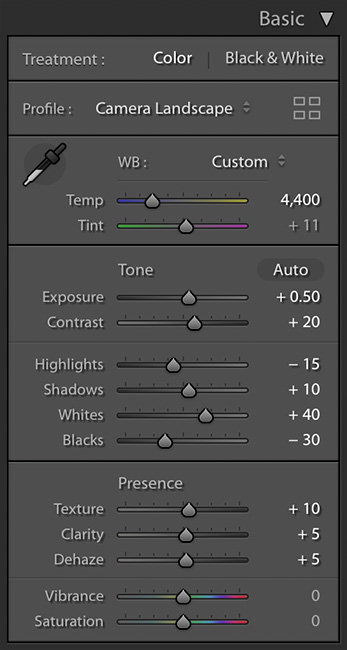
Lastly, don’t forget to add a bit of sharpening in the “Detail” sub-module. I bumped up Radius to 2.0 while keeping “Detail” at 50 and “Amount” at 40. Make sure to use Masking to only apply sharpening to the edges, so that you don’t end up with a bunch of noise in your images.
Moon Photography FAQ
Why Photograph the Moon?
So, why would one want to photograph the Moon? I was asked this question several times before and my answer is simple – because we only have one Moon and it is beautiful, so why not? The Moon makes the otherwise boring night sky look more interesting. While photographing the Moon by itself might be somewhat boring, including the Moon as an element of composition can yield great results. In addition, there are Moon phases (crescent to full) that give even more opportunities for various compositions. And lastly, why not experiment with something new and learn how to photograph bright objects at night?
Why Does the Moon Look Smaller in Pictures?
I’m sure if you have already attempted to take a picture of the Moon, you probably ran into a problem where the Moon looks tiny in comparison to what you saw while taking the picture. Why does the Moon get photographed so much smaller? The simple answer is – you are probably taking a picture of the Moon with a wide-angle lens. Keep in mind that your eyes are like a 50mm fixed lens and if you are taking a picture with a lens that is wider in angle of view than 50mm, the Moon will be captured in smaller size! So, if you want to capture an object like a big tree or a house with the Moon, you will need to stand further away and photograph the scene at least with a 50mm to try to match what you saw with your eyes. And even at 50mm, the Moon might look small, especially if it was near the horizon when you took a picture of it. This also happens because of a phenomenon called “Moon Illusion“, where the Moon appears bigger to your eyes, when in fact it is not.
Why Do I See the Moon as a White Blob?
If you have taken a picture of the Moon after sunset and it looked in like a white circular object rather than the Moon, it is because it was overexposed. When you take a picture of the Moon with other objects in the scene, your camera by default will calculate the exposure based on everything but the Moon. Take a look at the below image as an example:
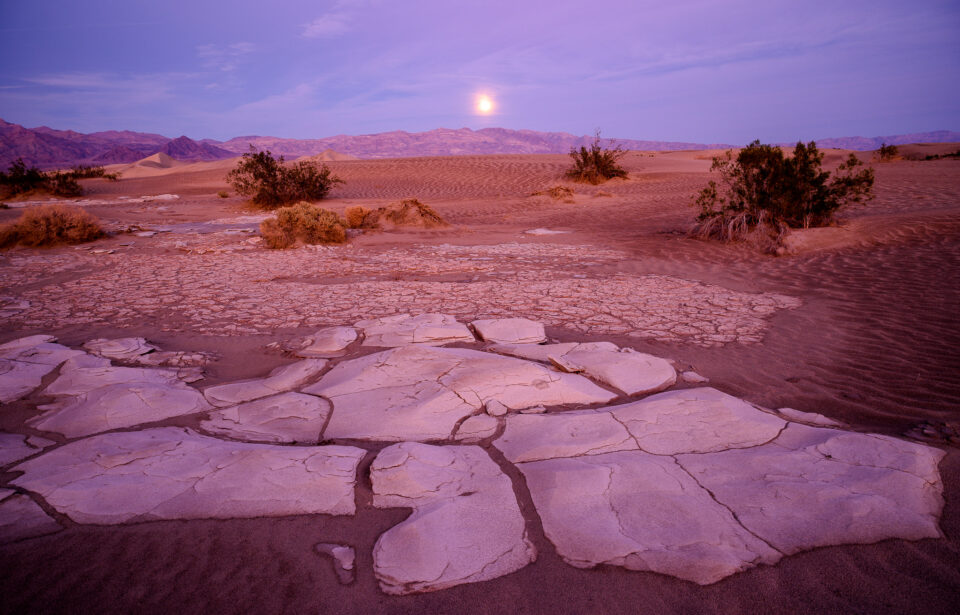
NIKON Z 6 + NIKKOR Z 24-70mm f/4 S @ 24mm, ISO 100, 4 sec, f/8.0
This happens because the Moon is too small in comparison to the objects around it and a single spot of light typically does not affect the light meter of your camera. This is not a problem during the day, because the moon’s brightness more or less matches the brightness of the sky. So, why do our eyes see everything normally, while a digital camera cannot? That’s because our eyes and our brain can see a much broader range of light. In photography terms, this is known as “dynamic range”.
Which Camera Gear is Best for Moon Photography?
You can photograph the Moon with any camera. However, if you want to photograph a close-up of the moon, you will need to use either a telescope coupled with a digital camera, or a compact camera with a super telephoto lens, such as the Nikon P900. An interchangeable lens camera coupled with a super telephoto lens is another option, although it might be the least cost-effective way to photograph the Moon.
How Do I Take Sharp Pictures of the Moon?
If you want to get a sharp photo of the Moon, you should first make sure to stabilize your setup to avoid any sort of camera shake. Next, you should use lens aperture that yields the best sharpness for your setup. Ideally, you should take many photos and then stack them in software to reduce the impact of elements in the atmosphere.